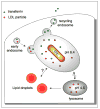Mycobacterium tuberculosis wears what it eats
- PMID: 20638643
- PMCID: PMC2929656
- DOI: 10.1016/j.chom.2010.06.002
Mycobacterium tuberculosis wears what it eats
Abstract
Mycobacterium tuberculosis remains one of the most pernicious of human pathogens. Current vaccines are ineffective, and drugs, although efficacious, require prolonged treatment with constant medical oversight. Overcoming these problems requires a greater appreciation of M. tuberculosis in the context of its host. Upon infection of either macrophages in culture or animal models, the bacterium realigns its metabolism in response to the new environments it encounters. Understanding these environments, and the stresses that they place on M. tuberculosis, should provide insights invaluable for the development of new chemo- and immunotherapeutic strategies.
Copyright 2010 Elsevier Inc. All rights reserved.
Figures




References
-
- Andries K, Verhasselt P, Guillemont J, Gohlmann HW, Neefs JM, Winkler H, Van Gestel J, Timmerman P, Zhu M, Lee E, et al. A diarylquinoline drug active on the ATP synthase of Mycobacterium tuberculosis. Science. 2005;307:223–227. - PubMed
-
- Axelrod S, Oschkinat H, Enders J, Schlegel B, Brinkmann V, Kaufmann SH, Haas A, Schaible UE. Delay of phagosome maturation by a mycobacterial lipid is reversed by nitric oxide. Cell Microbiol. 2008;10:1530–1545. - PubMed
Publication types
MeSH terms
Grants and funding
LinkOut - more resources
Full Text Sources
Other Literature Sources
Medical

